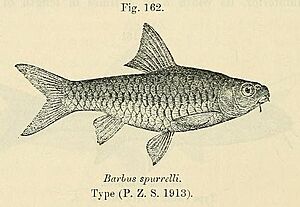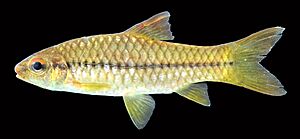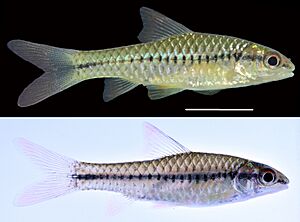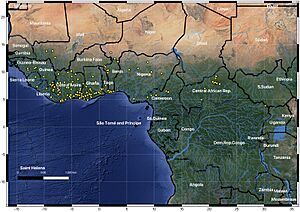Enteromius ablabes facts for kids
Quick facts for kids Enteromius ablabes |
|
|---|---|
 |
|
| Conservation status | |
| Scientific classification | |
| Synonyms | |
|
The Enteromius ablabes is a type of ray-finned fish that lives in the rivers of West Africa. It's part of a group of fish called Enteromius. You can find this fish from the dry Sahel region all the way to the coast, between countries like Guinea and Nigeria. It also lives further south in the central Congo Basin.
Scientists are still learning about how Enteromius ablabes is related to other fish in its family. It looks very similar to another fish called Enteromius punctitaeniatus. One main difference is the number of scales around its tail fin. Scientists also think there might be more than one species hiding under the name Enteromius ablabes. This means there could be different types of this fish that look alike but are actually separate species!
Contents
What Does it Look Like?
The Enteromius ablabes has a body that's not too flat and not too round. Its back curves up from its nose to its dorsal fin, then straightens out towards its tail. Its belly is also gently curved. This fish has a rounded snout and a mouth that's slightly underneath its head.
Fins and Scales
The eyes of the Enteromius ablabes are quite large and oval-shaped. It has a complete lateral line, which is a special sensory line that runs along its side. This line helps the fish feel vibrations in the water.
This fish has two barbels (whisker-like feelers) near its mouth. The front barbel is short, and the back one is longer. These barbels help the fish find food. Its scales are large and cover its whole body, even its belly. There are usually 22 to 27 scales along its lateral line.
The dorsal fin (on its back) is shaped like a triangle. The last ray in this fin is flexible and doesn't have any saw-like edges. Its pectoral fins (on its sides, like arms) and pelvic fins (on its belly) are also roughly triangular. The anal fin (near its tail on the bottom) is almost square. The tail fin is forked, meaning it splits into two points.
Colors and Markings
In real life, the Enteromius ablabes is usually straw-colored or yellow on top, fading to white on its belly. Sometimes, it has cool fluorescent turquoise marks above and below its lateral line. You might also see these turquoise marks on its head.
A dark stripe runs along its side, from its nose all the way to its tail fin. This stripe can be lighter on its head and darkest near its tail. Sometimes, there are darker vertical dashes on its scales, and a dark spot might be present at the base of its tail fin, connected to the side stripe. The edges of its other scales are often outlined with dark color. The top rim of its eye can be a burnt orange or red color.
Where Does it Live?
The Enteromius ablabes lives in rivers and basins along the Atlantic Coast and the Gulf of Guinea in West Africa. You can find it from the Senegal and Kaikouré rivers in the east to the Sanaga River in the west. It also lives in parts of the upper Lake Chad and upper Congo River basins.
Name Meaning
The name Enteromius ablabes comes from the Greek word "ablabes," which means "harmless." This name was given to the fish because its dorsal fin spine is flexible and doesn't have any sharp, saw-like edges.
Images for kids





